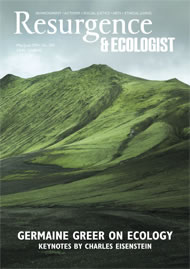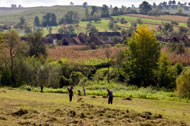Southern Transylvania in Romania is a special place, one of Europe’s last medieval landscapes. Famous for old towns and fortress-churches, it should be better known for its tapestry of varied and colourful wild flowers. After the long winter, pastures and hay meadows in this uncrowded, traditionally farmed countryside are bright with wild flowers from May to July, and also in early spring and autumn. The spectacle both lifts the soul and invokes sadness.
For so beautiful a carpet of flowers is something we in Western Europe and other advanced economies have lost – even though it is deeply ingrained in our culture, especially in Britain, a nation of gardeners, naturalists and writers. Politicians and modernists might say this doesn’t matter: it’s merely a consequence of progress, and any regret at its loss an aesthetic self-indulgence. Or do these flowers have value far beyond the human spirit?
Wild flowers all too often fall victim to progress, and Europe has seen decades of farming intensification and cumulative loss of biodiversity. Traditionally managed farmland, where it survives, remains a rich supportive ecosystem for wild plants and animals, frequently more so than many natural habitats. Alas, few such farmed landscapes survive, apart from in Eastern Europe, notably Transylvania. Here in the rolling wooded foothills of the Carpathian Mountains, traditional farmland vistas afford visitors an authentic glimpse of a lost Europe, a place where plants and animals that have disappeared elsewhere persist and thrive.
From the 12th and13th centuries, hardy German settlers (Sa?i or Saxons in Romanian) fortified their churches against Cuman, Tartar and Turk, and built planned villages of self-sufficient but mutually supportive farmsteads. Farming remained traditional and unmechanised, and until the 1980s this independent, conservative society retained many of the patterns of life of the original medieval farming communities.
Then, as Romania emerged from communism, most Saxons ‘returned’ to Germany, although their legacy endures in the mosaic of biodiversity-rich farmland habitats – and the only lowland farmed landscape in Europe to retain viable numbers of wolves and bears. A third of Romania’s 3,400 or so wild flowers occur here, among them more than 40 species Red-listed as of national conservation significance. Some 40% of the landscape is wooded, while 30% is grassland which is the motor of the rural economy that supports cattle and sheep, and yields high-quality honey, plus medicinal, dye and other useful plants.
Grassland provides essential ecological ‘goods and services’, locking up carbon and maintaining the health and integrity of soil, water, genetic variation of forage plants and the myriad animals that predate crop pests. This is organic agriculture by default. The Saxon Villages’ landscape illuminates harmonic links between biodiversity, non-intensive mixed farming and production of healthy food. The farmers, their wives and families need incomes and living standards to rise, but it would be a terrible ecological and cultural loss should the region be dominated by intensive farming on a few big farms. The wild flowers are iconic but, far more importantly, are integral to and indicative of a living, productive ecosystem.
These grasslands are fragile, and a single application of artificial fertiliser would raise fertility enough to encourage coarse grasses and thus degrade the wild plant diversity that far surpasses anything achievable by reseeding. Economic development must come, but, if sensitively directed, can be a model for sustainable farming anywhere. Meanwhile, although tractors are fast replacing horses, scythes and hoes, mixed farming survives and at dawn cattle, goats and horses still leave their barns for communal pastures, returning at dusk, in a scene from the 18th century or earlier.
But can these farming communities and landscapes survive in and beyond the 21st century – or is their destruction, as elsewhere in Europe, inevitable?
To protect this jewel of European landscape and ecology, in 2004 a group of like-minded British and Romanian friends and colleagues established Funda?ia ADEPT (Agricultural Development and Environmental Protection in Transylvania). We could see how landscape, wild flowers and wildlife faced two substantial threats: potential intensification of agriculture with overgrazing; and abandonment of uneconomic land, leading to scrub encroachment and loss of grassland. Conservation can only work if it has an economic role. So ADEPT puts farm economics and the needs of farming communities first, as the way to achieve lasting conservation of the wild flower-rich grasslands. By happy coincidence, 2014 is the United Nations’ International Year of Family Farming (the UN and European Commission have at last woken up to the fact that smaller-scale mixed farms are actually more productive, in food per hectare, than are industrial farms).
Working alongside Transylvanian universities and other Romanian NGOs, ADEPT has for 10 years carried out an integrated programme linking conservation and local incomes, with ecological research and mapping linked to agri-environment funding to support semi-subsistence farmers. Creative use of other funds is enhancing rural infrastructure, notably communal milk-collection points to serve small villages.
ADEPT has brought farmers’ markets to cities and supported ecotourism by linking villages with mountain bike trails. And user-friendly illustrated guides to subjects as diverse as food hygiene, important grassland wild flowers and local tourist attractions have proved effective to inspire local farmers and producers. This approach to nature conservation, based around farming communities rather than ‘conservation biology’, has influenced conservation stategy in the Carpathians and beyond. ADEPT staff are active in the design and implementation of EU and Romanian measures which support small-scale farmers to make nature conservation integral to farming.
Most Romanians are unaware of their country’s natural riches. Biodiversity plays an important role in this rich farming landscape and we need it to survive, alongside the traditional skills of local people, to ensure a sustainable future for the area. Helping these vulnerable human, plant and animal communities remains an uphill struggle. When we began nature conservation in the Saxon Villages, we marvelled at the sheer wealth of biodiversity. However, we now see accelerating trends that threaten their future.
Wild flower-rich meadows and pastures remain an essential element in the Transylvanian rural economy, and one cannot overestimate the ecological, cultural and economic value of this landscape and its resources. A precious, tangible link with the landscape and ecological processes of the past, wild flowers can also be at the heart of Europe’s farmed landscapes.
A three-day festival to celebrate Transylvanian culture and to support ADEPT’s work in Transylvania will be held in London 13–15 May 2014. For details see: www.Transylvaniafestival.co.uk, or write to [email protected].








